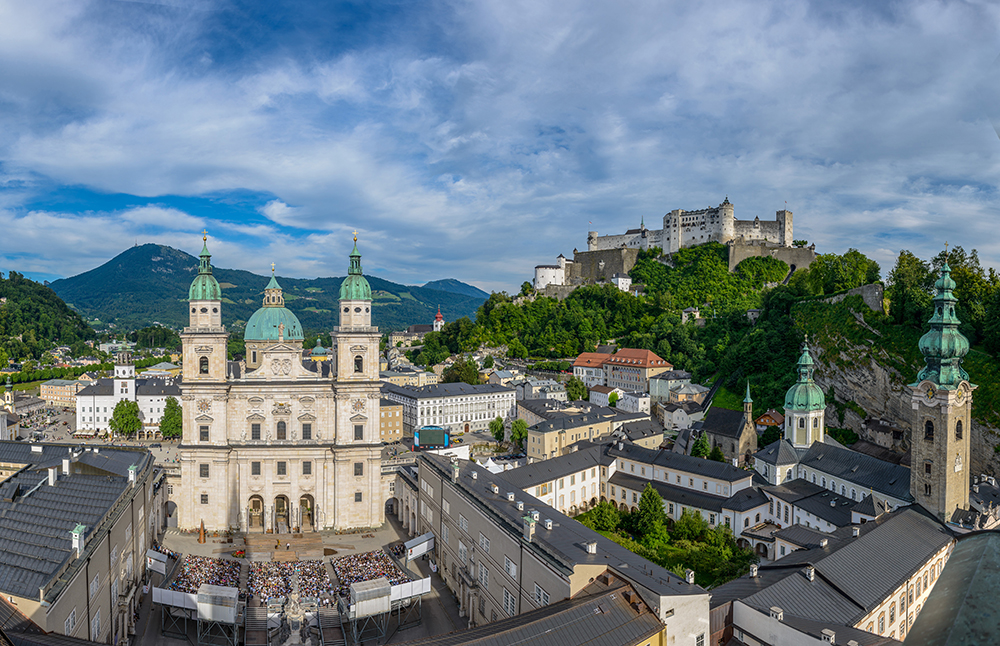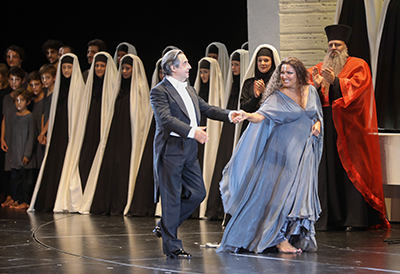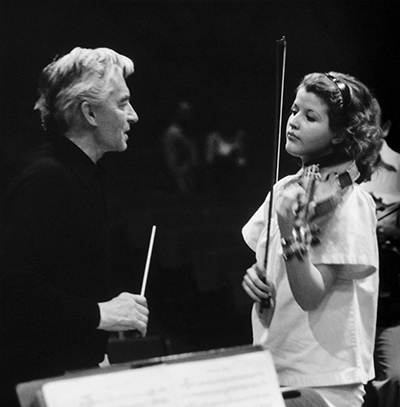
@Guenter Breitegger.
View over the Jedermann stage at the cathedral square.
Last summer, on the eve of its centennial year, the Salzburg Festival turned to Peter Sellars as its Keynote speaker of choice. Ever the provocateur, he jumped at the chance to lambast world leaders for their failure to act on global warming.
“How many hurricanes will it take?,” he posited. “How many heat waves, how much desertification, how much acidification, hypoxia, anoxia, melting of sea ice and glaciers, how much toxic air….”
He compared the heedless arrogance of today’s rulers to the hero of the opera he was directing in the Felsenreitschule. Idomeneo, he said, “operated impulsively and automatically.” He thought he was “quicker and more clever than Neptune and that he [could] postpone” disaster. The result: “a tidal wave which destroys an entire city creating new refugees, utterly unnecessary suffering, and thousands of dead victims.”
Political diatribes at the world’s most important and concentrated celebration of the high arts? Acknowledged summer playground to the likes of Riccardo Muti, Anna Netrebko, Anne-Sophie Mutter, Simon Rattle, and other royals?
In a recent interview, Festival Artistic Director Markus Hinterhäuser linked Sellars’s take on Idomeneo to the mission of the festival’s founders, 100 years ago: “This is our great challenge: to make sure that great works of arts can be communicated in 2020. That through their intelligence and creativity, artists make sure these works have relevance, at any given time.”
“We do not make art political,” said longtime Salzburg Festival President Helga Rabl-Stadler, “but we do raise questions.”
The festival today—200 opera, concert, and drama performances jampacked into six weeks and 16 venues, attracting tens of thousands of guests from 80 countries, half of them outside of Europe—is barely recognizable from its start on August 22, 1920, with a performance of Jedermann (Everyman), on the steps of the Salzburg Cathedral.
“We were founded as a project for freedom,” says Rabl-Stadler. “Because our founders believed in the strength and the power and the energy of the arts.”
She refers to director Max Reinhardt, composer Richard Strauss, and librettist/dramatist Hugo von Hofmannsthal, author of Jedermann, which, in another nod to heritage, is performed every year.
A beacon of culture, a triumph over devastation
Initially, there was talk of a festival devoted to Salzburg’s native son, akin to the Wagner festival in Bayreuth. But the founders had other, loftier ideas. Given the devastation inflicted by World War I and the disorientation that followed, they sought to create a beacon of culture for Europe and a new Austrian identity. The festival, says Rabl-Stadler, was intended to combat “crises—the crisis of meaning and loss of values, the crisis of identity of the individual human being as well as entire nations.”
Mozart’s music would be part of the mix, but one element among many. Reinhardt envisioned “a triumphal arch celebrating Austrian art, with Mozart as its crowning glory, in order to weave a new social fabric based on our shared European heritage.”
Practically speaking, Reinhardt recognized that an affluent clientele would be necessary to support the festival, especially if it was, indeed, for “Everyman.” In a 1917 memorandum, he wrote, “It has become apparent that the arts are not merely a luxury for the rich and sated, but food for the needy” and “a balm for their souls.”
Today, the festival generates 75 percent of its budget through ticket sales, sponsorships, contributions, and other income, with the rest coming from governmental entities. Tax revenues from the economic activity the festival generates actually exceed the amount of its government subsidies. The top ticket price for opera is €450, but, true to Reinhardt’s ideals, approximately half of all tickets are priced between €5 to €105.
History in the making
The Vienna Philharmonic is largely viewed as the festival’s “house band.” Without it, says Rabl-Stadler, “there might be a festival in Salzburg, but it would not be the Salzburg Festival.” The affiliation dates to 1922, also a year that saw four Mozart operas, two conducted by founder Strauss. Bruno Walter made his debut in 1925 with Don Pasquale, the first opera by a composer other than Mozart, and two years later the first “contemporary” opera (composed in 1916) appeared—Strauss’s Ariadne auf Naxos. Walter conducted the first Wagner opera, Tristan und Isolde, in 1933; Toscanini arrived two years later for the first time, with Falstaff.
“All at once,” Austrian author Stefan Zweig wrote in his 1941 memoir Die Welt von Gestern (The World of Yesterday: Memories of a European),“the Salzburg Festival became a world attraction, as it were, the Olympic Games of Art in the modern era, in which all nations competed to present their best achievements.”
For a while, the Festival was a bastion against fascism; Hitler forbade Germans from going to it. But the Anschluss in 1938 had appalling consequences. Reinhardt, who was Jewish, had departed for Britain and then the U.S., where he directed his famous film, A Midsummer Night’s Dream (1935); he died in New York in 1943, aged 70. (Hofmannsthal, whose great grandfather was Jewish, died in 1929.) Jedermann and Reinhardt’s production of Faust was removed from the repertoire, although Hofmannsthal’s librettos for Strauss were not banned. Toscanini, slated to conduct five operas in 1938, refused to return. Wartime deprivations reduced the festival’s operations to a minimum, with authorities forbidding the 1944 premiere of Strauss’s Die Liebe der Danae, although the dress rehearsal famously went ahead.
With the end of World War II, the festival faced conditions similar to those at its origin but worse, given the Nazi atrocities and tensions between allied powers that prevailed. Astonishingly, barely three months after the Nazi surrender, the first post-war festival was held, which included new productions of Hofmannsthal’s Der Tor und der Tod and Mozart’s Die Entführung aus dem Serail. Restoring the Salzburg event was in fact a priority for General Mark W. Clark, commander of the American occupying forces in Austria. Clark regarded the festival as a step toward the goal of a free and independent Austria. More than ever, Austria and Europe were in need of the regenerative powers of art and culture recognized by the founders.
The Karajan era
Following denazification procedures, Wilhelm Furtwängler led memorable performances of operas until his death in 1954; denazification was also required for Herbert von Karajan, who made his debut in 1948, and Karl Böhm (1938), each of whom had first appeared before the war. Karajan in 1956 he became artistic director; during his more than 30 years at the helm, the festival increasingly became his fiefdom—he was sometimes called the “uncrowned king” of Salzburg—as it also grew in international profile. His supremely polished performances drew automotive metaphors from critics to describe their high precision. The heights he achieved with the Berlin Philharmonic became part of the Salzburg experience, threatening (but by no means ending) Vienna’s status as the main orchestra.
For operas, he often entrusted the stage direction to himself, typically in collaboration with set designer Günther Schneider-Siemsen. With Karajan’s opera performances, it was said, the real drama was in the orchestra pit, and what transpired on stage was an extension of it. Under Karajan the festival was fundamentally about musical execution and interpretation. But after his death in 1989, change was essential.
Fresh beginnings
That arrived with the appointment of Gerard Mortier, formerly general director of Brussels’s La Monnaie, as artistic director. He was known as a provocateur, at least that's how he was portrayed in the press, much to his own delight. A production of Messiaen’s St. François d’Assise, the centerpiece of the first of his ten festivals (1992-2001), was directed by Peter Sellars with Esa-Pekka Salonen and the Los Angeles Philharmonic in the pit. Its departure from convention, in virtually all aspects, loudly proclaimed that change was in the air. Sellars’s 1997 staging of György Ligeti’s phantasmagorical farce Le Grand Macabre as an antinuclear tract so incensed the composer that he reportedly wanted to sue. In his final festival, Mortier produced a Fledermaus actually calculated to be booed. Yet it was through Mortier that the festival regained its intellectual edge and attained the form in which it essentially operates today.
Rabl-Stadler became president of the Festival in 1995 and to this day she remains a dominant figure there, holding de facto veto power over much of what artistic directors can do. She has made great strides as a fundraiser in a country where governmental support remains generous. And she has been a source of stability, not least during the relatively short tenures of Mortier’s first three successors, each of whom nevertheless brought something distinctive to the festival. Peter Ruzicka (2002-2006), a composer, engineered the celebration of Mozart 250th birthday in 2006 by staging all 22 of his operas. He also featured music by composers suppressed by the Nazis, such as Korngold and Schreker, and brought back artists, such as Muti and Nikolaus Harnoncourt, who had fallings-out with Mortier. Jürgen Flimm (2007-2010) followed, a colorful figure who had previously headed the gritty, contemporary Ruhr Triennale.
He was succeeded by the ever ambitious Alexander Pereira (2012-14), who successfully instituted the still-extant, weeklong pre-festival Ouverture spirituelle, devoted to sacred music. Pereira, in a coup, also engaged Bartoli to head the Whitsun Festival and advocated a policy largely continued today of performing operas only in new productions. He planned to premiere a new opera every year, of which Thomas Adés’s The Exterminating Angel and Marc-André Dalbavie’s Charlotte Salomon were products. Ultimately, the idea proved overly ambitious and was abandoned.
Unlike his predecessors in the post-Mortier era—and, for that matter, Mortier himself—Hinterhäuser, a pianist now in his third year as artistic director, had a long previous association with the Salzburg Festival, and it shows in the smoothness with which its disparate and complex parts function under his leadership. During the Mortier years, Hinterhäuser ran Zeitfluss, a new music series within the festival, and from 2006-2010 he headed concert programming. He was interim artistic director in 2011, and has since proved his mettle at the top with ambitious, artistically intriguing projects.
The audience is challenged, he concedes, but fundamentally it’s a matter of trust. “The trust we have in our audience is repaid by their trust in us.” His programming brilliantly epitomizes the founders’ wisdom in favoring a festival with a significantly broad base. With its thematic interconnections, ample representation of new music, and in-depth investigation of composers and performers, a typical Salzburg program will look mouthwatering to many and perhaps a bit daunting to others.
Ancient myths, modern challenges
Last summer’s over-arching theme of myths from antiquity embraced George Enescu’s rarely done Oedipe, along with six of the composer’s instrumental works in concert. Myths also animated the drama program, which included the world premiere of Theresia Walser’s Die Empörten (The Outraged Ones), an updating of the Antigone story. The popular Austrian actor Tobias took the title role in Jedermann. Theater performances are in German, but the institution of English supertitles in 2017 has helped to broaden their audience.
Apart from Sellars’s Idomeneo, conducted by Teodor Currentzis, Andreas Kriegenburg sensibly updated Simon Boccanegra, and Alcina benefitted from a masterful portrayal of the title role by Cecilia Bartoli. Barrie Kosky’s production of Orphée aux enfers was eye-poppingly zany. Achim Freyer produced Oedipe, with Christopher Maltman in stunning form as the protagonist, Simon Stone cleverly updated Cherubini’s Médée. Doing yeoman service, the Vienna Philharmonic was in the pit for five of the seven staged operas.
It is hard to imagine that, as its centenary approaches, the Salzburg Festival has ever been healthier. All three of the principal sectors—opera, drama, concerts—are flourishing. The stimulating programming common to all reinforces the festival’s artistic breadth and intellectual cachet as envisioned by its founders. Hinterhäuser and Rabl-Stadler have come up with a formula for transforming their forebears’ vision into a reality for modern audiences. And in today’s troubled world, this achievement could hardly be more welcome. No doubt they will make the 100th anniversary something extraordinary. It is sure to be worth waiting for. •
With reporting by George Loomis.
Susan Elliott first covered the Salzburg Festival in the 1980s and has written about the performing arts for most of her career. She is the News and Special Reports Editor for Musical America.
Musical America Musicians of the Year Pay Tribute to Salzburg
 Riccardo Muti, Musician of the Year, 2010
Riccardo Muti, Musician of the Year, 2010
The Salzburg Festival is part of my artistic life. I’ve gone every year but one since I started in 1971. Half a century! I don’t know whether to be proud or embarrassed by that!
When I started, it was the place where you could meet the world’s greatest artists: Oistrakh, Rostropovich, Karajan, [Mozarteum Director Bernard] Paumgartner—he was a big authority and physically a huge man. For a young man like me to see him walking down the corridor was very scary. I felt like a small entity in a big temple.
The golden period for me was the Karajan years. When he died in 1989, I conducted the Verdi Requiem with the Berlin Philharmonic in Salzburg. He was a very special musician and he helped many young conductors during that time—now we are all old. PHOTO: Curtain calls for Riccardo Muti (Conductor) and Anna Netrebko (Aida) in Verdi’s Aida, 2017. © Salzburg Festival/Franz Neumayr.)
When Karajan invited me to do Così fan tutte, it was a turning point in my career. It was 1979 and I was touring the United States with the Philharmonia Orchestra of London. It was my last tour with them—I had already been appointed music director of Philadelphia. [Muti was with that orchestra from 1980 to 1992.]
The last concert on the Philharmonia tour was in—can you imagine?—Raleigh, North Carolina. At 7 o’clock in the morning the telephone rang in my hotel room. I said to my wife, “Who is this kook calling me at 7 o’clock in the morning?” I picked up the telephone and I heard a voice, very stentorious, “Sono Karajan.”
I said to my wife, who was still in bed, “There’s an idiot here who says he is Karajan, can you imagine?” And then I heard in an even more stentorious way, “Il SONO Karajan.” So I understood this was not a joke.
I said, “Maestro, how did you FIND me?” And he said in Italian—he spoke good Italian—“If you want to find somebody, you find them.”
It was quite scary.
He said, “Muti, I would like you to do Così fan tutte, 1982.” I said, “Maestro, I have never conducted Così fan tutte, but I know that the opera was the greatest success of the festival in the last five years in the production conducted by Karl Böhm. So for me, young Italian, to do Così fan tutte after Böhm, it would be suicide. Can you give me time to think about?”
And Karajan said, “Si or Non.”
So I said, “OK, maestro, I accept, but it is your responsibility. Are you sure of what you are doing?” And he said, “Si.”
And it was really a great success in 1982. Michael Hampe directed a fantastic production that today would be called old-fashioned. (The world has changed completely!) It was a great cast.*
The fact that this young Italian had this great success with Mozart in Salzburg was a revelation and a great achievement for me. In the history of my life and of the festival, that Così is a special story.
Next summer, I will conduct the Beethoven Nine with the Vienna Philharmonic; they will do just one of his symphonies for the 250th anniversary and it is for me to do—100 years of the festival, 50 years of my time there. It’s quite a year.
*Margaret Marshall, Agnes Baltsa, Francisco Araiza, James Morris, Kathleen Battle, José van Dam.
 Anne-Sophie Mutter, Musician of the Year, 2011
Anne-Sophie Mutter, Musician of the Year, 2011
“In my formative years, the Salzburg Festival was an extraordinary library and educational campus for me. [The famed violinist made her Salzburg debut at age 13 under Herbert von Karajan.] Since it was so close to my home, I was able to attend many of Karajan’s productions and saw the most important musicians in the world perform. One can see that Salzburg has changed and is moving into the 21st century in terms of contemporary music and productions which are even more inventive as it approaches its 100th anniversary. It is my hope that many more young artists will benefit from the resources of the Salzburg Festival as it begins its second century.” PHOTO: Herbert von Karajan and Anne-Sophie Mutter. © Siegfried Lauterwasser/Deutsche Grammophon.)
Anna Netrebko, Musician of the Year, 2008
“The Salzburg Festival is one of the most important festivals in our industry. It is a place where the best musicians come from all over the world to create wonderful
performances. I am very humbled to sing with them.”